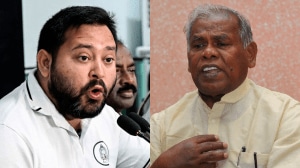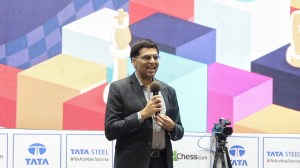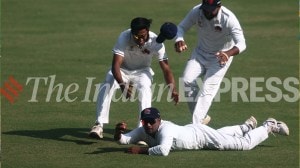The five-hat theory
Greg Chappell (coach):Conductor, composerHis biggest influence on the team has been the change he has brought about in the way players think...

Greg Chappell (coach):
Conductor, composer
His biggest influence on the team has been the change he has brought about in the way players think. Be it the out-of-form Virender Sehwag making way for in-form opener Gautam Gambhir, seniors dropping down the order for the sake of Experiment No.3 or even players being left out of the squad altogether in search of new options, his decisions have been accepted though after initial hiccups.
Much of that is down to his constant emphasis on the fact that he’s building a team for the 2007 World Cup, everything till then is effectively an experiment. The corrollary to this is his ability to assure his charges that they will be given enough time to prove themselves. One failure will not mean the end of a fledgling career.
Once the players have bought into his vision, it’s become easier for him to put his other plans into action. There is, for example, much more discussion within the team about the game, especially after a nets session. “There are times when one knows the answer to a problem but becomes aware of this knowledge only through discussion’’, Chappell says.
There were many who though Chappell was talking through his coloured hat when he started off on de Bono and lateral thinking early on in his tenure but the idea seems to be paying off now.
Rahul Dravid (captain)
Semi-conductor
There is much talk of his being a dummy captain, a pushover caught between a domineering coach, a vastly experienced senior and an eager deputy. But Dravid brings to his job a quiet, understated assurance and confidence that allows him to balance all of the above. So Sachin Tendulkar can do the field placings, Virender Sehwag and even MS Dhoni can offer their suggestions. And Dravid will stand back and watch, one eye on the scoreboard, half a mind on the over rate and full confidence in the way things are going.
Dravid’s analytical approach to the game, a keen sense of history and experience of playing against almost every other top contemporary cricketer make him the practical yang to Chappell’s theoretical yin. In the John Wright era, Dravid would come up with innovative inputs on-field placements. Today he doesn’t have to wait for them to be implemented; he just needs to wave his hand.
Virender Sehwag
(vice-captain)Elder Brother
He’s now not just a batting explosion waiting to happen; he’s a pro-active leader who’s revealed a shrewdness of mind, a hunger for success and a willingness to work hard for it. All that, an an earthy, frank and humorous nature that doesn’t deal in metaphor and simile but gets straight to the point. The juniors in the team can’t stop talking about the positive energy Sehwag brings to the dressing room. “He’s the best person to talk to when you’re feeling low’’, says JP Yadav. While Dravid is known to be guarded about his views, Sehwag is the opposite. And, as he showed at Ahmedabad and Rajkot, he can make his displeasure known in the case of a misfield or wayward bowling.
The new faces hold Dravid and Tendulkar in awe but have no problem connecting with Sehwag. During the prize ceremony at Rajkot he nudged, winked and clapped with a hearty laugh when RP Singh was named Man of the Match. He’s the quintessential elder brother, looking out for his younger siblings, equally able to give them a cuff around the ear or an arm over the shoulder.
Sachin Tendulkar
Mentor, Maestro
Greg Chappell’s single biggest success would be the reincarnation of Sachin. It’s not known what exactly Chappell has told him but it included a guarantee that he didn’t have to worry about his place in the side. There would, however, be one trade-off: he’d have to nurture the kids.
He began his mentor’s role at the Bangalore camp where, in the absence of Dravid and Sehwag, he was the de facto captain. Once the walls came down — he is a couple of cricketing generations older than many teammates, and was playing Tests when Suresh Raina was a babe-in-arms – others started hitting him for advice. And when the series began his inputs became even more crucial. He was the one who, famously, suggested that Irfan bat at No 3. He’s usually chatting with Irfan and Agarkar and is always around when Harbhajan gets the ball. Even at the nets, he bowls his leggies alongside the off-spinner.
Support Staff
(John Gloster, physio; Gregory King, trainer; Ian Frazer, sports scientist; S Ramakrishnan, computer analyst; Dr Charles Krebs, kinesiologist)
Helping Hands
On Friday, a day before the last match of the series coach, Greg Chappell gave a vote of thanks: ‘‘Without the help of the support staff, we wouldn’t have been able to achieve this result.’’ It needed to be said because, for the first time in several years, two things happened: India had almost no injury problems through the series and the planning, rather than talent and momentum, played a large role in the success. The work of the support stuff has no one dazzling, match-winning innovation. Instead, it’s a steady, intensive, laborious, anonymous process off the field that eventually leads to a perceptible change on it.
It helped this time that the area of focus was not, as usual, the playing XI but pretty much the entire squad. ‘‘We’ve seen players being all prepared despite sitting out for several matches in a row’’, pointed out Rahul Dravid. Indeed, the constant work put in by Frazer, King and Gloster helped Gautam Gambhir and RP Singh hit the ground running when they were drafted in. And towards the end of the series Krebs was asked to focus on the younger brigade.
Frazer, the former first-class cricketer from Victoria, used his playing experience – and many, many hours of practice – to help Harbhajan find new angles and get the pacers to bowl just short of a good length.
And then there’s Ramki, the computer analyst. One programme he introduced at the pre-series Bangalore camp helped players watch their action instantly, like a TV action replay. Another, a portable media player given to each player, works as a
motivational tool by enabling them to watch their best cricketing moments just before they bat.
Three months after being outplayed in Lanka, India turned the tables. Here’s how they plotted the downfall of the world’s second best ODI side
Bowling: Follow The Plan
The Lankan batsmen have a reputation of spoiling the career of a number of Indian bowlers; this time, the boot was on the other foot, thanks to India’s newly formed pace attack and innovative planning.
Chappell gave his bowlers a one-point agenda: pitch the ball just short of a good length. With that came the supplementaries: Never change your plan, even if you’re hit all over the park. Don’t think about Plan B, you won’t need it. And don’t think about your bowling averages, you’ll be judged on your ability to follow a plan. And so at Rajkot, even when young pacers S Sree Santh and RP Singh went for runs in their initial overs, they kept running in with the same intention as earlier.
Off-spinner Harbhajan Singh was given different advice. Since his was a familiar craft for the Lankans, he was asked to work on new angles to give more variation to his bowling. He also worked on bowling over the wicket more often. So whenever the left-handers took strike Bhajji changed the line. Result: He got over his poor early-season form to become the most consistent bowler of the series.
Batting:
Striking Strategy Since the Lankan bowling attack is known for its discipline and accuracy, the Indian batsmen needed some practice against tight bowling. Come in Ian Frazer. The biomechanist was turned into a nets bowler, with a twist: He would throw, not bowl, the ball on the perfect spot, time and time and time again. The batsmen would get enough chance to figure out how to work the ball away or go for the shots.
The other plan that worked for India against the Lankan bowlers was the power play rule. The Lankan spinners have the ability to choke the opposition in the middle overs by spreading the field and bowling an immaculate line and length. But the second power play meant fewer fielders on the fence and more scope for the Indian batsmen to go for their shots. All they needed to do was hit over the circle and, with fast outfields at most centres, a boundary was theirs for the asking. Sri Lanka couldn’t figure out a counter to this. When these two teams last played, in the tri-series in Sri Lanka last August, the power plays hadn’t been effected. This time, the impact was significant.
Fielding:
Age Is The Edge The youth policy paid off for India, the plethora of academy trained, supremely fit youngsters giving hem an edge in the field.. Stumps were hit with increasing frequency, meaning both runs saved and run-outs effected. The Lankans had an older side, one that seemed tired and shorn of its usual sparkle in the field. And injuries to Jayasuriya and Muralitharan meant they were carrying too many passengers.
— Sandeep Dwivedi


- 01
- 02
- 03
- 04
- 05





























